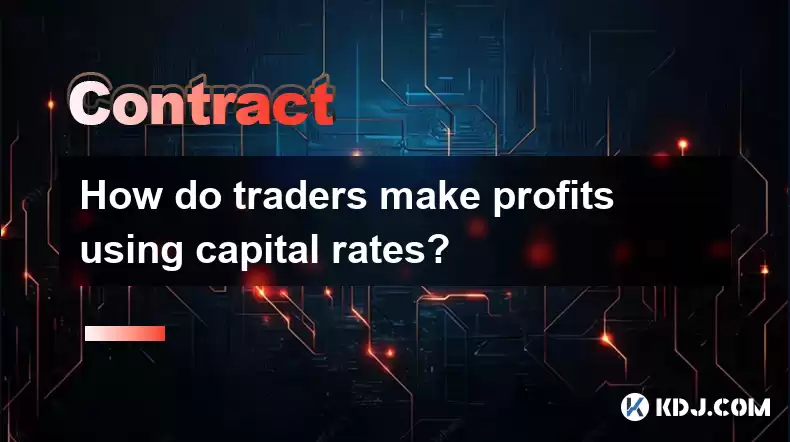-
 bitcoin
bitcoin $87959.907984 USD
1.34% -
 ethereum
ethereum $2920.497338 USD
3.04% -
 tether
tether $0.999775 USD
0.00% -
 xrp
xrp $2.237324 USD
8.12% -
 bnb
bnb $860.243768 USD
0.90% -
 solana
solana $138.089498 USD
5.43% -
 usd-coin
usd-coin $0.999807 USD
0.01% -
 tron
tron $0.272801 USD
-1.53% -
 dogecoin
dogecoin $0.150904 USD
2.96% -
 cardano
cardano $0.421635 USD
1.97% -
 hyperliquid
hyperliquid $32.152445 USD
2.23% -
 bitcoin-cash
bitcoin-cash $533.301069 USD
-1.94% -
 chainlink
chainlink $12.953417 USD
2.68% -
 unus-sed-leo
unus-sed-leo $9.535951 USD
0.73% -
 zcash
zcash $521.483386 USD
-2.87%
How do traders make profits using capital rates?
Traders leverage differences in capital rates offered by cryptocurrency exchanges through arbitrage strategies, amplifying returns with the judicious use of margin while meticulously managing risk.
Feb 20, 2025 at 12:36 am

- Understanding capital rates and their impact on trading strategies
- Leveraging capital rate arbitrage for profit generation
- Utilizing leverage to amplify returns while managing risk
How do traders make profits using capital rates?
In the cryptocurrency market, capital rates play a pivotal role in shaping trading strategies and facilitating profit generation. Here's a comprehensive guide on how traders capitalize on capital rates to maximize their returns:
Understanding Capital Rates
Capital rates, also known as funding rates, represent the premium or discount paid by traders holding a long or short position in a perpetual futures contract. They are determined by the demand and supply dynamics in the market, reflecting the cost of borrowing or lending an asset.
Leveraging Capital Rate Arbitrage
One common strategy is to exploit capital rate arbitrage, which involves simultaneously holding opposite positions in different exchanges that offer contrasting capital rates. By capitalizing on the rate difference, traders can generate a spread profit without taking on a specific market direction.
For instance, if Exchange A offers a capital rate of -0.02% and Exchange B offers a rate of 0.03%, a trader can establish a long position on Exchange A and a short position on Exchange B. This strategy generates a profit equal to the 0.05% capital rate spread.
Utilizing Leverage to Amplify Returns
Traders can also leverage capital rates to enhance their returns. By using borrowed funds or margin trading, they can increase their position size and amplify potential profits. However, it is crucial to manage risk effectively, as leverage magnifies both gains and losses.
To illustrate, suppose a trader deposits 1 BTC as collateral and borrows 9 additional BTC from an exchange offering a capital rate of 0.04%. Holding a long position with the 10 BTC, they may generate a profit of 0.04 BTC (0.04% * 10 BTC) in interest if the capital rate remains unchanged.
FAQs on Capital Rates in Cryptocurrency Trading
Q: What factors influence capital rates?A: Supply and demand, funding costs, market sentiment, and market liquidity all contribute to capital rate fluctuations.
Q: Can capital rates be used to forecast price movements?A: While capital rates provide insights into market sentiment, they are not reliable indicators of future price movements.
Q: Is it possible to profit consistently from capital rate trading?A: Generating consistent profits from capital rate trading requires a robust understanding of the market, risk management best practices, and ongoing monitoring of capital rate dynamics.
Disclaimer:info@kdj.com
The information provided is not trading advice. kdj.com does not assume any responsibility for any investments made based on the information provided in this article. Cryptocurrencies are highly volatile and it is highly recommended that you invest with caution after thorough research!
If you believe that the content used on this website infringes your copyright, please contact us immediately (info@kdj.com) and we will delete it promptly.
- Ray Dalio's Portfolio Prescription: Why Bitcoin and Gold Are Essential in a Debt-Ridden World
- 2025-12-19 01:35:01
- Taiwan's Bitcoin Trove: Criminal Investigations Unearth a Surprising Global Ranking
- 2025-12-19 01:30:02
- Coinbase's Bold Leap: Stocks, Prediction Markets, and the Future of Trading
- 2025-12-19 01:35:01
- Kaito, Kickstarter, and the Post-TGE Crash: Navigating Crypto's Volatile Launch Landscape
- 2025-12-19 01:15:01
- Jito Foundation's Onshoring Signals a New Dawn for Solana and Crypto Regulation in the US
- 2025-12-19 01:25:01
- Cardano's Midnight Token (NIGHT) Shines Amidst Crypto Economy Evolution, Highlighting Privacy and Next-Gen Potential
- 2025-12-19 01:15:01
Related knowledge

How Does the Liquidation Engine Work on a Crypto Exchange?
Dec 19,2025 at 05:59am
Core Mechanism of Margin Liquidation1. When a trader opens a leveraged position, the exchange assigns an initial margin requirement and a maintenance ...

Why is Risk-to-Reward Ratio Crucial in Futures Trading?
Dec 08,2025 at 01:20am
Risk-to-Reward Ratio Defined1. The risk-to-reward ratio quantifies the potential loss against the potential gain for a single futures trade. It is cal...

A Step-by-Step Guide on How to Short Bitcoin with Futures.
Dec 07,2025 at 06:39pm
Understanding Bitcoin Futures Contracts1. Bitcoin futures are standardized agreements to buy or sell BTC at a predetermined price and date in the futu...

Understanding the Relationship Between Leverage and Margin.
Dec 14,2025 at 02:39am
Core Mechanics of Leverage in Crypto Trading1. Leverage allows traders to control a larger position size than their available capital would normally p...

How to Reduce Trading Fees on Your Futures Account.
Dec 11,2025 at 01:20pm
Understanding Fee Structures in Futures Trading1. Exchanges apply distinct fee models based on order type—maker orders add liquidity and receive rebat...

What is the Difference Between Futures and Options Trading?
Dec 18,2025 at 12:40pm
Futures Trading Mechanics1. A futures contract is a standardized agreement to buy or sell a specific asset at a predetermined price and date in the fu...

How Does the Liquidation Engine Work on a Crypto Exchange?
Dec 19,2025 at 05:59am
Core Mechanism of Margin Liquidation1. When a trader opens a leveraged position, the exchange assigns an initial margin requirement and a maintenance ...

Why is Risk-to-Reward Ratio Crucial in Futures Trading?
Dec 08,2025 at 01:20am
Risk-to-Reward Ratio Defined1. The risk-to-reward ratio quantifies the potential loss against the potential gain for a single futures trade. It is cal...

A Step-by-Step Guide on How to Short Bitcoin with Futures.
Dec 07,2025 at 06:39pm
Understanding Bitcoin Futures Contracts1. Bitcoin futures are standardized agreements to buy or sell BTC at a predetermined price and date in the futu...

Understanding the Relationship Between Leverage and Margin.
Dec 14,2025 at 02:39am
Core Mechanics of Leverage in Crypto Trading1. Leverage allows traders to control a larger position size than their available capital would normally p...

How to Reduce Trading Fees on Your Futures Account.
Dec 11,2025 at 01:20pm
Understanding Fee Structures in Futures Trading1. Exchanges apply distinct fee models based on order type—maker orders add liquidity and receive rebat...

What is the Difference Between Futures and Options Trading?
Dec 18,2025 at 12:40pm
Futures Trading Mechanics1. A futures contract is a standardized agreement to buy or sell a specific asset at a predetermined price and date in the fu...
See all articles









































































